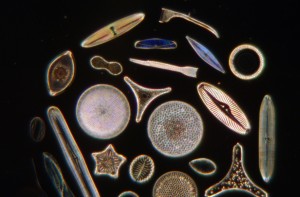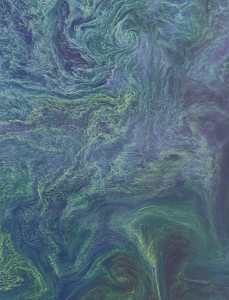Biogeochemistry
Ocean turbulence and biology
 The bulk of the marine biomass is concentrated in plankton organisms of micrometers to millimeters size, like the diatoms shown on the left. On these scales, ocean turbulence dominates the physical and chemical environment by constantly moving water around. The strong turbulence generated by winds and air-sea heat and freshwater fluxes at the ocean surface keeps nutrients and plankton uniformly distributed in the vertical within the surface mixed layer (the upper ocean layer where microtrbulence on scales less than 100 meters is strongest). In addition turbulent mesoscale and submesoscale eddies stir tracers laterally control the supply of nutrients from the ocean abyss into the surface mixed layer. So the life cycle of phytoplankton is in synchrony with turbulent physics.
The bulk of the marine biomass is concentrated in plankton organisms of micrometers to millimeters size, like the diatoms shown on the left. On these scales, ocean turbulence dominates the physical and chemical environment by constantly moving water around. The strong turbulence generated by winds and air-sea heat and freshwater fluxes at the ocean surface keeps nutrients and plankton uniformly distributed in the vertical within the surface mixed layer (the upper ocean layer where microtrbulence on scales less than 100 meters is strongest). In addition turbulent mesoscale and submesoscale eddies stir tracers laterally control the supply of nutrients from the ocean abyss into the surface mixed layer. So the life cycle of phytoplankton is in synchrony with turbulent physics.
Turbulent eddies may well be a key determinant of the structure and function of the entire marine foodweb: the average structure of marine ecosystems may reflect the integrated, and rectified, effects of turbulent processes, modulating primary production, community structure and hence the export of organic carbon to the interior ocean. The turbulent circulation and life within it, acts and interacts locally, and yet has global consequences for climate. Using our expertise in ocean turbulence, we use observations, theory and numerical models to understand the interaction of ocean physics and marine ecosystems on regional scales and we then extrapolate our results to global scales relevant for climate.
Previously working on this theme: John Taylor and Louis-Philippe Nadeau.
Phytoplankton blooms
 The annual cycle of phytoplankton growth in many parts of the ocean is dominated by a rapid, intense population explosion in late winter or early spring, the so-called spring bloom. The increase in the phytoplankton population associated with the spring bloom accounts for up to a third of the annual phytoplankton production and contributes significantly to the carbon flux to the deep ocean. The spring bloom occurs globally in coastal seas, lakes, in the Mediterranean and Black Seas, and most famously in the North Atlantic where the associated change in ocean color can be seen from space. Our group is currently studying what physical conditions prompt the onset of a bloom. Our group has been investigating the development of blooms in the North Atlantic using new autonomous floats equipped by optical instruments. These new data is opening a new window on ocean ecosystems and revolutionizing our understanding of marine blooms.
The annual cycle of phytoplankton growth in many parts of the ocean is dominated by a rapid, intense population explosion in late winter or early spring, the so-called spring bloom. The increase in the phytoplankton population associated with the spring bloom accounts for up to a third of the annual phytoplankton production and contributes significantly to the carbon flux to the deep ocean. The spring bloom occurs globally in coastal seas, lakes, in the Mediterranean and Black Seas, and most famously in the North Atlantic where the associated change in ocean color can be seen from space. Our group is currently studying what physical conditions prompt the onset of a bloom. Our group has been investigating the development of blooms in the North Atlantic using new autonomous floats equipped by optical instruments. These new data is opening a new window on ocean ecosystems and revolutionizing our understanding of marine blooms.
Now working on this theme: Mara Freilich.
Previously working on this theme: Alexandre Mignot, John Taylor.